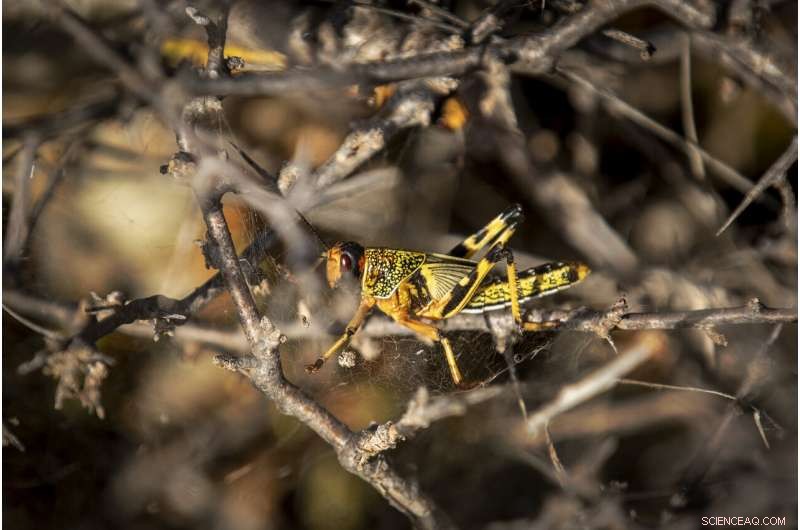
Nesta foto tirada terça-feira, 4 de fevereiro, 2020, um jovem gafanhoto do deserto que ainda não criou asas está preso em uma teia de aranha em um arbusto espinhoso no deserto perto de Garowe, na região semi-autônoma de Puntland, na Somália. Os gafanhotos do deserto neste trecho árido do norte da Somália parecem menos ameaçadores do que os enxames de bilhões de membros que infestam a África Oriental, mas os jovens gafanhotos saltitantes são a próxima onda do surto que ameaça mais de 10 milhões de pessoas em toda a região com uma grave crise de fome. (AP Photo / Ben Curtis)
Num relance, os gafanhotos do deserto nesta área árida do norte da Somália parecem menos ameaçadores do que os enxames de bilhões de membros que infestam a África Oriental no pior surto que alguns lugares já viram em 70 anos.
Mas sua hora chegará.
Pequeno e sem asas, os jovens gafanhotos saltitantes são a próxima onda do surto que ameaça mais de 10 milhões de pessoas em toda a região com uma grave crise de fome.
E eles estão crescendo em um dos lugares mais inacessíveis do planeta. Grandes partes da Somália ao sul desta região semi-autônoma de Puntland estão sob ameaça, ou detido por, o grupo extremista al-Shabab ligado à Al Qaeda. Isso torna difícil ou impossível realizar a pulverização aérea dos gafanhotos que, segundo os especialistas, é o único controle eficaz.
A Somália declarou o surto de emergência nacional. Em toda a região, tem o potencial "de ser a praga mais devastadora de gafanhotos em qualquer uma de nossas memórias vivas se não reduzirmos o problema mais rápido do que estamos fazendo no momento, "O chefe humanitário da ONU, Mark Lowcock, disse.
Enquanto um policial somali armado aguardava, Na quinta-feira, especialistas caminharam pela terra seca repleta de jovens gafanhotos e explicaram a ameaça que viria se o mundo não agir agora.
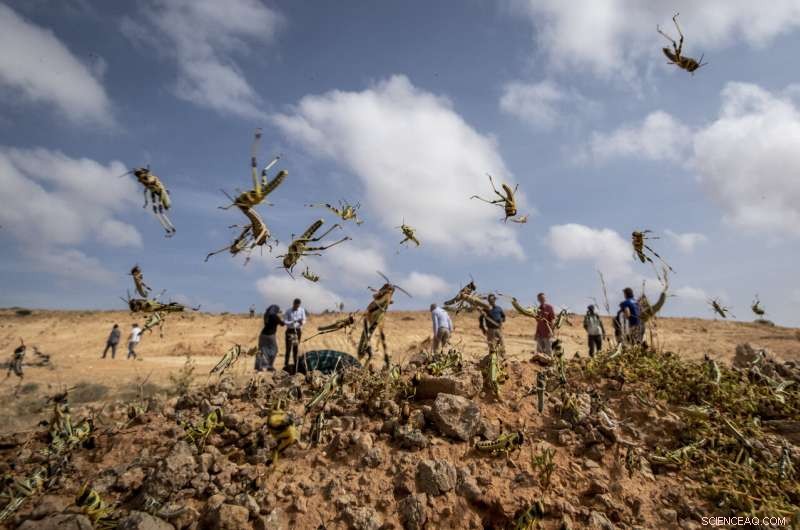
Nesta foto tirada quarta-feira, 5 de fevereiro, 2020, jovens gafanhotos do deserto que ainda não desenvolveram asas saltam no ar à medida que se aproximam, como observa uma delegação visitante da Organização para a Alimentação e Agricultura (FAO), no deserto perto de Garowe, na região semi-autônoma de Puntland, na Somália. Os gafanhotos do deserto neste trecho árido do norte da Somália parecem menos ameaçadores do que os enxames de bilhões de membros que infestam a África Oriental, mas os jovens gafanhotos saltitantes são a próxima onda do surto que ameaça mais de 10 milhões de pessoas em toda a região com uma grave crise de fome. (AP Photo / Ben Curtis)
"O mundo precisa saber que é aqui que tudo começa, "disse Alberto Trillo Barca, um porta-voz da Organização das Nações Unidas para Alimentação e Agricultura. "Nas próximas três ou quatro semanas, essas ninfas, como os chamamos, desenvolverá asas. "
Em seguida, eles devem partir para os vizinhos Quênia e Etiópia, onde um punhado de aviões pulverizando pesticidas só podem fazer muito se esses enxames continuarem chegando.
Especialistas em clima apontaram chuvas excepcionalmente fortes, auxiliado por um poderoso ciclone ao largo da Somália em dezembro, como um fator importante no surto. Os gafanhotos foram carregados pelos ventos da tempestade da Península Arábica e partes além, e agora estão se alimentando da vegetação fresca da Somália.
Com mais chuvas previstas na região nas próximas semanas, o número de gafanhotos, se não for controlado, pode aumentar em até 500 vezes até junho, quando se espera um tempo mais seco.
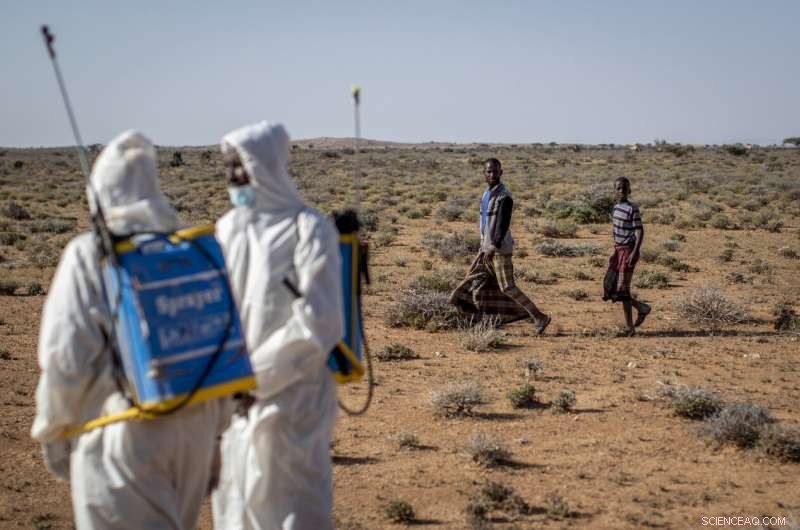
Nesta foto tirada terça-feira, 4 de fevereiro, 2020, Pulverizadores de controle de pragas somalis demonstram seu trabalho nos arbustos espinhosos do deserto, que é o terreno fértil de gafanhotos do deserto para uma delegação visitante de funcionários do ministério somali e especialistas da Organização para Agricultura e Alimentação (FAO), no deserto perto de Garowe, na região semi-autônoma de Puntland, na Somália. Os gafanhotos do deserto neste trecho árido do norte da Somália parecem menos ameaçadores do que os enxames de bilhões de membros que infestam a África Oriental, mas os jovens gafanhotos saltitantes são a próxima onda do surto que ameaça mais de 10 milhões de pessoas em toda a região com uma grave crise de fome. (AP Photo / Ben Curtis)
Mas esse clima mais seco não é necessariamente a solução, disse Dominique Burgeon, o diretor de emergência e resiliência da FAO.
A densidade dos gafanhotos agora é tão alta que mesmo a umidade normal pode levar a outra geração, ele disse.
"Não podemos acreditar na Mãe Natureza para resolvê-lo, " ele explicou.
Sem pulverização suficiente para parar os enxames, o surto já preocupante pode se transformar em uma praga, "e quando você tem uma praga, leva anos para controlar, " ele disse.
Contra essa perspectiva abrangente, alguns trabalhadores mascarados com roupas de proteção brancas e recipientes de pesticidas amarrados às costas estavam no deserto da Somália atravessado por camelos, borrifando os milhares de gafanhotos agarrados a arbustos espinhosos.
As mudanças climáticas do mundo trazem o risco de mais ciclones vindos do aquecimento do Oceano Índico ao largo da África Oriental, especialistas em clima dizem. Com isso, a probabilidade de novos surtos de gafanhotos aumenta.
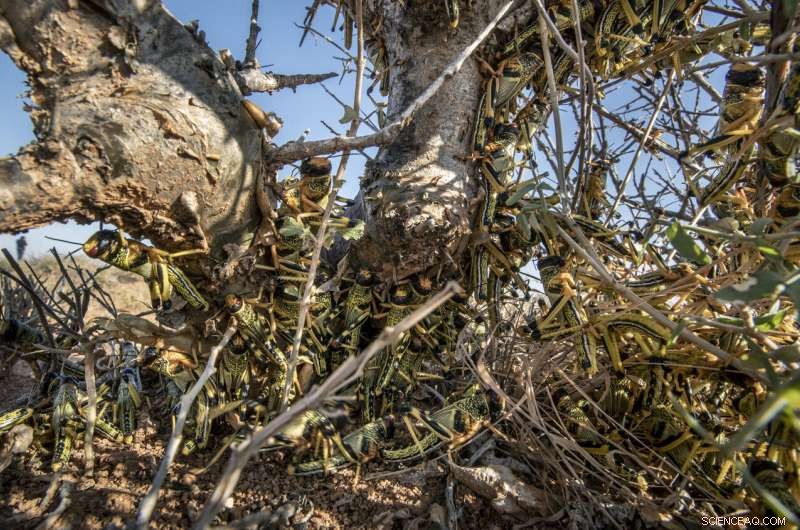
Nesta foto tirada terça-feira, 4 de fevereiro, 2020, jovens gafanhotos do deserto que ainda não desenvolveram asas se aglomeram em um arbusto espinhoso no deserto perto de Garowe, na região semi-autônoma de Puntland, na Somália. Os gafanhotos do deserto neste trecho árido do norte da Somália parecem menos ameaçadores do que os enxames de bilhões de membros que infestam a África Oriental, mas os jovens gafanhotos saltitantes são a próxima onda do surto que ameaça mais de 10 milhões de pessoas em toda a região com uma grave crise de fome. (AP Photo / Ben Curtis)
O "tipo de novo normal, "Disse Burgeon.
E isso significa Quênia, A Etiópia e outros países da África Oriental, que raramente vêem esses surtos e se encontram amplamente despreparados para isso, podem se juntar aos "países da linha de frente" em partes da África Ocidental e do Oriente Médio, especialistas falam. Esses países têm sistemas de monitoramento e prevenção bem treinados para surtos mais frequentes de gafanhotos.
A FAO pediu a doadores internacionais para dar $ 76 milhões imediatamente para ajudar a controlar este surto. Até agora $ 19 milhões estão em mãos, Burgeon disse.
"The biggest challenge is the scale of the breeding, as you can see all around us, " Barca said. These locusts, ele disse, will be migrating to southern Somalia and parts of Kenya and Ethiopia just as crops are germinating there.
"If at that time there are huge quantities of locusts around, it will have a devastating impact on the crops, " Burgeon said.
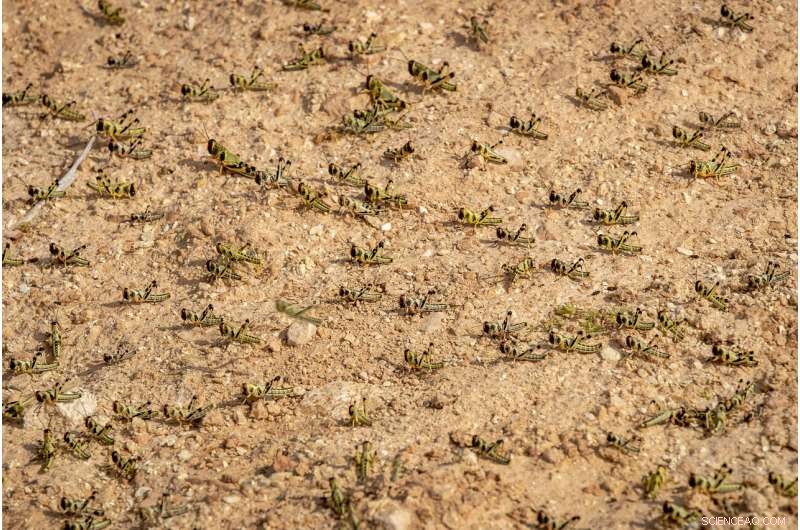
In this photo taken Wednesday, Feb. 5, 2020, young desert locusts that have not yet grown wings cover the ground in the desert near Garowe, in the semi-autonomous Puntland region of Somalia. The desert locusts in this arid patch of northern Somalia look less ominous than the billion-member swarms infesting East Africa, but the hopping young locusts are the next wave in the outbreak that threatens more than 10 million people across the region with a severe hunger crisis. (AP Photo/Ben Curtis)
Other East African countries including Uganda, South Sudan, Eritrea and Djibouti are also at risk, Burgeon said. Millions of people in some of these places are already facing hunger in the wake of civil war or more common challenges such as poverty.
Here in rural Somalia, where about 50% of the people depend on animals for their livelihoods, the locusts are eating the pasturage. The animals weaken, their milk decreases and small children, who depend on the milk to survive, suffer skyrocketing malnutrition, disseram os especialistas.
Those fighting the locust outbreak may try to negotiate with Somalia's extremist fighters to allow spraying in rural areas where they are active, Burgeon said. Already emergency workers are going in where they can.
In a few weeks the young locusts will shed their skin, said Keith Cressman, a senior locust forecasting officer with the FAO.
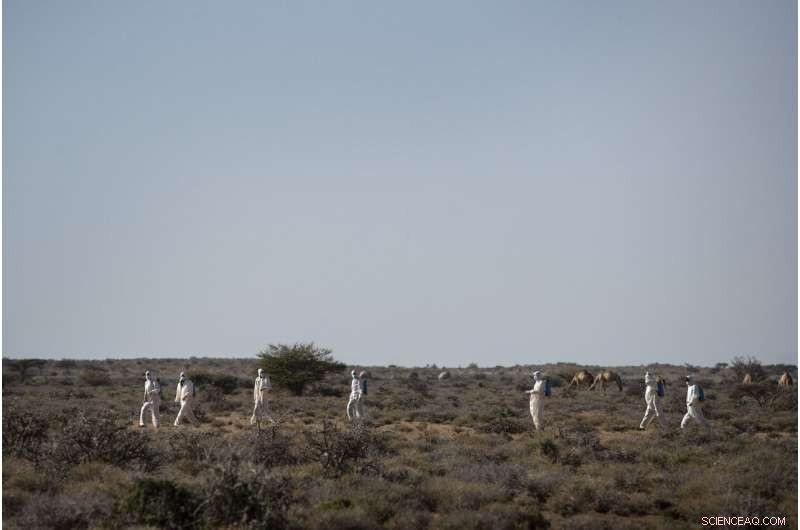
In this photo taken Tuesday, Feb. 4, 2020, Somali pest-control sprayers demonstrate their work on the thorny bushes in the desert that is the breeding ground of desert locusts for a visiting delegation of Somali ministry officials and experts from the Food and Agriculture Organization (FAO), in the desert near Garowe, in the semi-autonomous Puntland region of Somalia. The desert locusts in this arid patch of northern Somalia look less ominous than the billion-member swarms infesting East Africa, but the hopping young locusts are the next wave in the outbreak that threatens more than 10 million people across the region with a severe hunger crisis. (AP Photo/Ben Curtis)
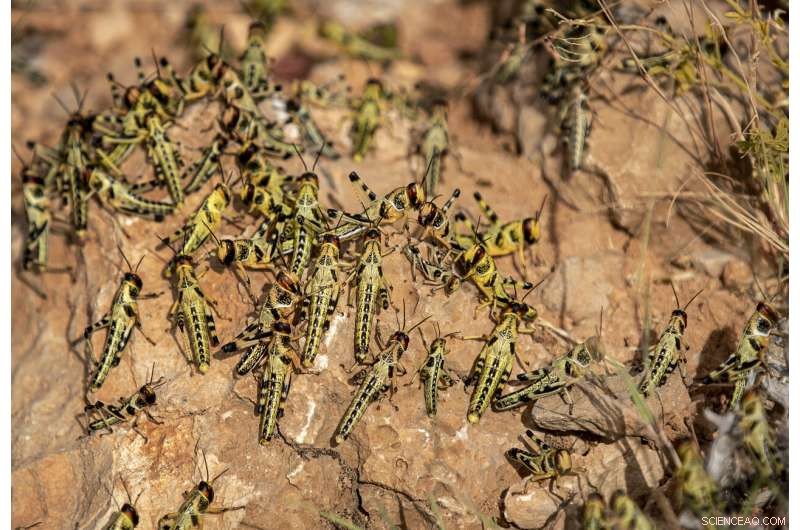
In this photo taken Wednesday, Feb. 5, 2020, young desert locusts that have not yet grown wings crowd together on a rock in the desert near Garowe, in the semi-autonomous Puntland region of Somalia. The desert locusts in this arid patch of northern Somalia look less ominous than the billion-member swarms infesting East Africa, but the hopping young locusts are the next wave in the outbreak that threatens more than 10 million people across the region with a severe hunger crisis. (AP Photo/Ben Curtis)
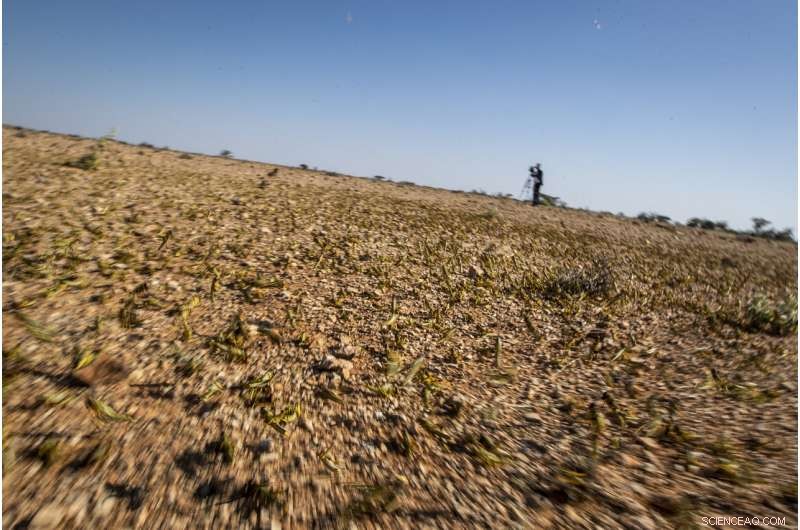
In this photo taken Tuesday, Feb. 4, 2020, young desert locusts that have not yet grown wings jump in the air as they are approached in the desert near Garowe, in the semi-autonomous Puntland region of Somalia. The desert locusts in this arid patch of northern Somalia look less ominous than the billion-member swarms infesting East Africa, but the hopping young locusts are the next wave in the outbreak that threatens more than 10 million people across the region with a severe hunger crisis. (AP Photo/Ben Curtis)
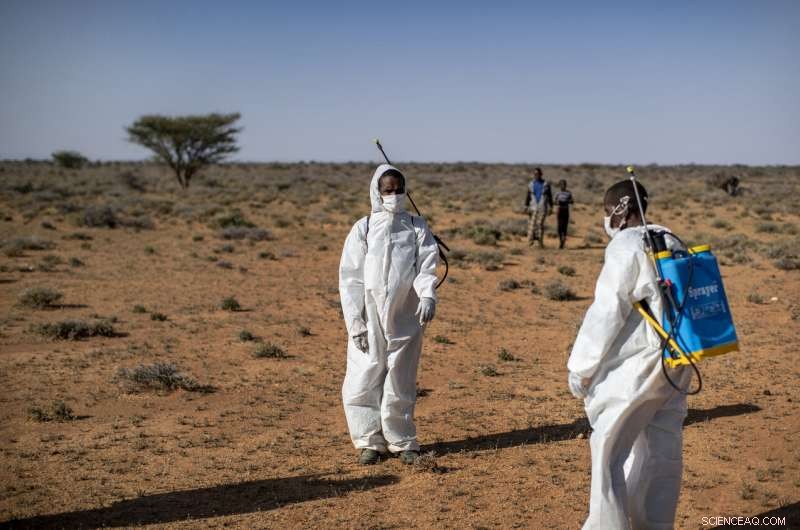
In this photo taken Tuesday, Feb. 4, 2020, Somali pest-control sprayers demonstrate their work on the thorny bushes in the desert that is the breeding ground of desert locusts for a visiting delegation of Somali ministry officials and experts from the Food and Agriculture Organization (FAO), in the desert near Garowe, in the semi-autonomous Puntland region of Somalia. The desert locusts in this arid patch of northern Somalia look less ominous than the billion-member swarms infesting East Africa, but the hopping young locusts are the next wave in the outbreak that threatens more than 10 million people across the region with a severe hunger crisis. (AP Photo/Ben Curtis)
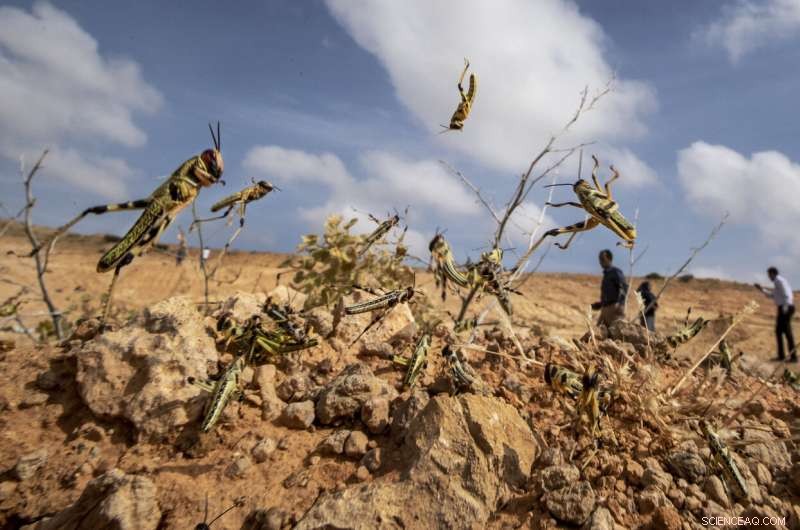
In this photo taken Wednesday, Feb. 5, 2020, young desert locusts that have not yet grown wings jump in the air as they are approached, as a visiting delegation from the Food and Agriculture Organization (FAO) observes them, in the desert near Garowe, in the semi-autonomous Puntland region of Somalia. The desert locusts in this arid patch of northern Somalia look less ominous than the billion-member swarms infesting East Africa, but the hopping young locusts are the next wave in the outbreak that threatens more than 10 million people across the region with a severe hunger crisis. (AP Photo/Ben Curtis)
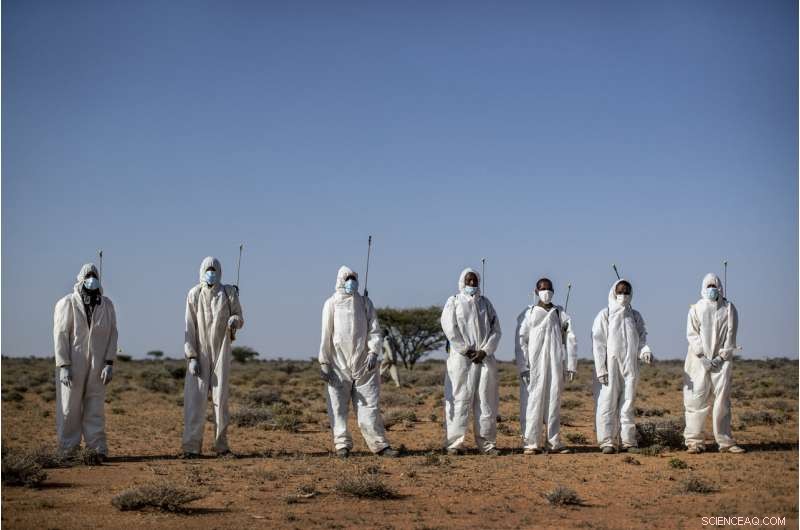
In this photo taken Tuesday, Feb. 4, 2020, pest-control sprayers demonstrate their work on the thorny bushes in the desert that is the breeding ground of desert locusts for a visiting delegation of Somali ministry officials and experts from the Food and Agriculture Organization (FAO), in the desert near Garowe, in the semi-autonomous Puntland region of Somalia. The desert locusts in this arid patch of northern Somalia look less ominous than the billion-member swarms infesting East Africa, but the hopping young locusts are the next wave in the outbreak that threatens more than 10 million people across the region with a severe hunger crisis. (AP Photo/Ben Curtis)
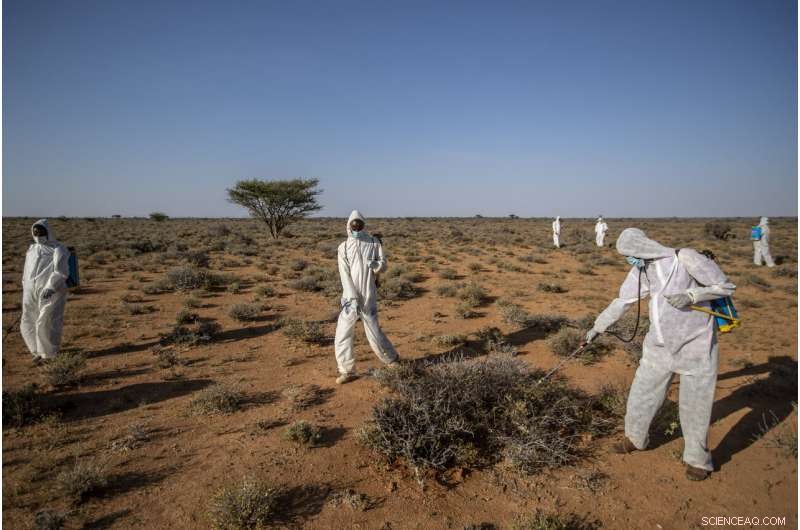
In this photo taken Tuesday, Feb. 4, 2020, pest-control sprayers demonstrate their work on the thorny bushes in the desert that is the breeding ground of desert locusts for a visiting delegation of Somali ministry officials and experts from the Food and Agriculture Organization (FAO), in the desert near Garowe, in the semi-autonomous Puntland region of Somalia. The desert locusts in this arid patch of northern Somalia look less ominous than the billion-member swarms infesting East Africa, but the hopping young locusts are the next wave in the outbreak that threatens more than 10 million people across the region with a severe hunger crisis. (AP Photo/Ben Curtis)
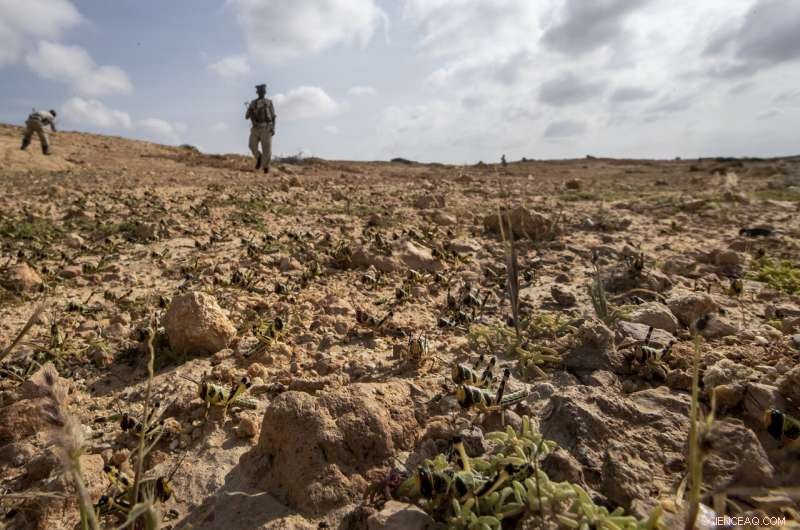
In this photo taken Wednesday, Feb. 5, 2020, a policeman looks at young desert locusts that have not yet grown wings covering the ground in the desert near Garowe, in the semi-autonomous Puntland region of Somalia. The desert locusts in this arid patch of northern Somalia look less ominous than the billion-member swarms infesting East Africa, but the hopping young locusts are the next wave in the outbreak that threatens more than 10 million people across the region with a severe hunger crisis. (AP Photo/Ben Curtis)

In this photo taken Wednesday, Feb. 5, 2020, an official from the Food and Agriculture Organization (FAO) demonstrates the "eLocust3" software used to record and track the location and movements of locusts using GPS and transmit the data via satellite, in the desert near Garowe, in the semi-autonomous Puntland region of Somalia. The desert locusts in this arid patch of northern Somalia look less ominous than the billion-member swarms infesting East Africa, but the hopping young locusts are the next wave in the outbreak that threatens more than 10 million people across the region with a severe hunger crisis. (AP Photo/Ben Curtis)

In this photo taken Wednesday, Feb. 5, 2020, Dominique Burgeon, Centro, Director of the Emergency and Resilience Division of the Food and Agriculture Organization (FAO) and Keith Cressman, direito, Senior Locust Forecasting Officer for FAO, walk in the desert between Garowe and Qardho, in the semi-autonomous Puntland region of Somalia. The desert locusts in this arid patch of northern Somalia look less ominous than the billion-member swarms infesting East Africa, but the hopping young locusts are the next wave in the outbreak that threatens more than 10 million people across the region with a severe hunger crisis. (AP Photo/Ben Curtis)
"It takes a few days to warm up their wings, " he said. Some test flights follow and they're on the move.
The locusts at that stage are bright pink and in their most voracious state, like "very hungry teenagers, " Cressman said. By now, many people in Kenya and Ethiopia know them well.
After a month or so, the locusts will be mature adults, ready to reproduce.
Soon after copulating and laying eggs the locusts will die, "but their progeny will be hatching, " Cressman said. "And we have another generation of locusts to contend with, with about another 20-fold increase."
© 2020 Associated Press. Todos os direitos reservados.